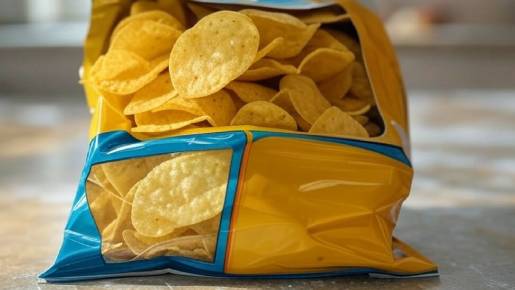The Shocking Truth Behind Half-Empty Chip Bags
Ever opened a bag of chips only to feel cheated by how much air is inside? You’re not alone. Millions of snack lovers worldwide share this frustration. But did you know that this packaging strategy is not just about tricking consumers—it actually serves a purpose? More importantly, this very problem led to one of the biggest snack food innovations in history—the invention of Pringles. 🏆
The Viral Chip Bag Protest: A Floating Statement
Two South Korean students, fed up with half-empty chip bags, made headlines when they built a raft using 160 unopened snack bags. 🚤 Surprisingly, the raft actually floated! Their viral protest reignited global discussions about excessive packaging, misleading marketing, and product value.
But beyond consumer frustration, this issue sparked real innovation—leading to one of the most successful patented food products of all time.
Why Are Chip Bags Full of Air? The Science Behind the Packaging
Before we dive into Pringles’ game-changing invention, let’s understand why snack companies use so much air in their bags:
✔ Cushioning: That “air” inside your chip bag acts as a shock absorber, preventing your chips from breaking during transport. ✔ Freshness Preservation: The gas inside isn’t ordinary air—it’s nitrogen. Unlike oxygen, nitrogen prevents chips from going stale by keeping moisture and oxidation at bay. ✔ Marketing Tactics: While the science is sound, some argue that bigger bags create the illusion of more product than what’s actually inside. A clever marketing move? Maybe.
The Pringles Innovation: A Patented Breakthrough in Snacks
In the 1960s, Procter & Gamble (P&G) set out to solve these packaging problems. They wanted a chip that:
🔹 Wouldn’t break easily. 🔹 Wouldn’t be greasy. 🔹 Wouldn’t rely on oversized, air-filled bags.
The solution? A revolutionary new type of chip.
🔹 Instead of slicing potatoes, P&G developed a method to mash them into a dough and shape them into identical, stackable curves. 🔹 To prevent breakage, they designed a cylindrical can that provided optimal protection. 🔹 The result? No more wasted space. No more crushed chips. Just perfection.
How Patents Protected the Pringles Empire
Pringles wasn’t just an instant hit—it was a patented success. The unique shape, texture, and even the canister design were all protected by patents, preventing competitors from copying the product.
🚀 Innovation is powerful, but protecting your ideas is just as crucial. If P&G had not patented their design, copycats could have easily flooded the market, diluting their brand and profits.
Case Study: How Patents Drive Business Success
One of the biggest reasons Pringles remains a dominant player in the snack industry is its patents. Patents provided P&G with an exclusive market advantage, preventing direct imitation for decades. The success of Pringles proves a vital business lesson—
A great idea alone isn’t enough; it needs protection to thrive.
💡 Can food packaging be patented?
Yes! Unique packaging designs, materials, and preservation techniques can be patented if they offer a novel function or improvement.
💡 How do patents protect food innovations?
Patents prevent competitors from copying unique food processing methods, formulations, and packaging designs, securing market exclusivity.
💡 How long does a food-related patent last?
Utility patents (for processes and compositions) last 20 years, while design patents (for packaging) typically last 15 years.
Got a Game-Changing Idea? Protect It Now!
If you’ve invented something unique—whether it’s in food, tech, or any other industry—securing a patent can safeguard your business and maximize its profitability.
👉 Book a free consultation today to discuss your invention and how you can legally protect it before competitors try to copy it.
📞 Contact us now:
🌐 PatentYogi.com
📧 office@patentyogi.com
PS: What’s the most surprising patent you’ve ever heard of? Share in the comments!👇

